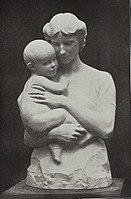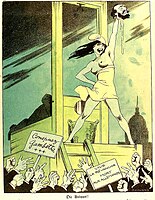
Oskar Theodor Garvens (20 November 1874 – 18 November 1951) was a German sculptor and caricaturist.
Born in Hanover in 1874, and educated at the Academy of Fine Arts, Munich, Garvens was a supporter of traditional schools of art and mocked cubism in particular.
In 1911, Garvens married Margarete Unger, and they had two children, Klaus (born 1912 in Berlin) and Ursula (born 1914).
As well as publishing work in the influential arts magazine Jugend, during the 1920s Garvens became one of the leading illustrators for the satirical magazine Kladderadatsch, which identified with "militant conservatism" and was an early supporter of the Nazi Party.
Garvens sometimes signed his work with a monogram of a small letter "o" inside a larger capital "G".
He died in Berlin in 1951.
Gallery
-
 Statue in Stadtfriedhof, Hanover
Statue in Stadtfriedhof, Hanover
-
 "My wife and my young son", c. 1914
"My wife and my young son", c. 1914
-
 Caricature of Friedrich Ebert, 1919
Caricature of Friedrich Ebert, 1919
-
 "Combing her hair", 1927
"Combing her hair", 1927
-
 "The Answer", 1927
"The Answer", 1927
-
 "The Peace brought down", September 1939
"The Peace brought down", September 1939
Notes
- ^ "Oskar Garvens", Musée d'Orsay, accessed 7 July 2023
- "Oskar Garvens", Netherlands Institute for Art History at rkd.nl, accessed 8 July 2023
- "The Art of Caricature - Oskar Garvens (1874–1951) looks at cubism and naturalism" in New Statesman and Nation, Vol. 102 (1981), p. 17
- Edward Lucie-Smith, The Art of Caricature (London: Orbis Publishing, 1981, ISBN 978-0856130700), p. 120
- "Oskar Garvens", online-ofb.de, accessed 8 July 2023
- ^ Franz Goldstein, "Garvens, Oskar Theodor, Berlin, geb. Hannover 1874, gest. 1951; Bildhauer, Karikaturist, Zeichner, Mitarbeiter der „Jugend“" in Internationales Verzeichnis der Monogramme bildender Künstler seit 1850 (Walter de Gruyter GmbH, 2020), p. 285
- Lasse Wichert, Personale Mythen des Nationalsozialismus: Die Gestaltung des Einzelnen in literarischen Entwürfen (Verlag Wilhelm Fink, 2018), pp. 327, 333
- Klaus Haese, Wolfgang Schütte, Frau Republik geht pleite: Deutsche Karikaturen der zwanziger Jahre (Leipzig, 1989), pp. 114, 132